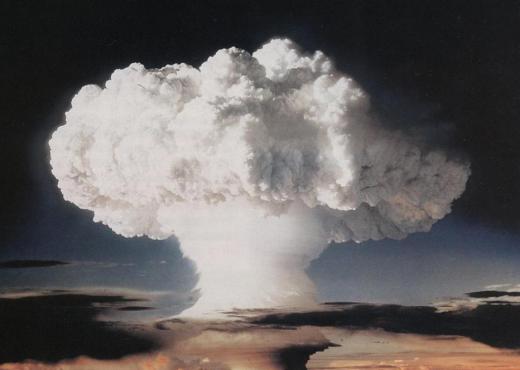What Was Project Pluto?
 Michael Anissimov
Michael Anissimov
Project Pluto was a SLAM, or Supersonic Low-Altitude Missile, an audacious Cold War project designed to make a nuclear-powered under-the-radar ballistic missile. The research was conducted by scientists from the Lawrence Radiation Laboratory, predecessor of the Lawrence Livermore National Laboratory, while testing took place at the Nevada Test Site, where the majority of nuclear tests during the era took place. The project ran from 1957 to 1964. It was canceled when improvements in radar technology made its low-flying qualities obsolete, and intercontinental ballistic missile technology turned out to be easier to develop than expected.
Project Pluto's signature component was a 513 megawatt unshielded nuclear reactor which heated air sucked in from the front of the missile, and fired it out the back. This arrangement is called a ramjet, or an air-breathing missile. The Pluto missile was designed to travel Mach 3 at treetop level. Its nuclear reactor would have emitted lethal radiation across a large radius. It was designed to be a missile-bomber, dropping multiple nuclear warheads as it traveled along its path of destruction. We should all be thankful that Project Pluto was never completed.

Project Pluto, if the device were actually built, probably would have been the craft experiencing the most in-flight stress of any airframe outside of spacecraft or ballistic missiles reentering from above the atmosphere. The reactor operated at 2,500°F (1,600 °C), temperatures at which conventional materials would melt within minutes. Special ceramics were used for the reactor components instead. Due to the efficiency of its nuclear engine, the Project Pluto missile could have stayed in the air for months if need be, circling the Pacific until it was ordered to strike a target. The missile may have had the highest power density of any piece of military hardware at the time, packing half a gigawatt of power into a package the size of a railway car.

Though Project Pluto was a military pursuit, it underscores the power of nuclear propulsion for aeronautical or astronautical applications in general. Relative to using conventional chemicals to power planes or rockets, there is just no comparison. Nuclear power provides superior power for fractions of a cent on the dollar when compared to chemical combustion. If the safety challenges surrounding nuclear reactors can be solved, then their use could open up the skies - and space - for the long-term future.
AS FEATURED ON:
AS FEATURED ON:













Discuss this Article
Post your comments